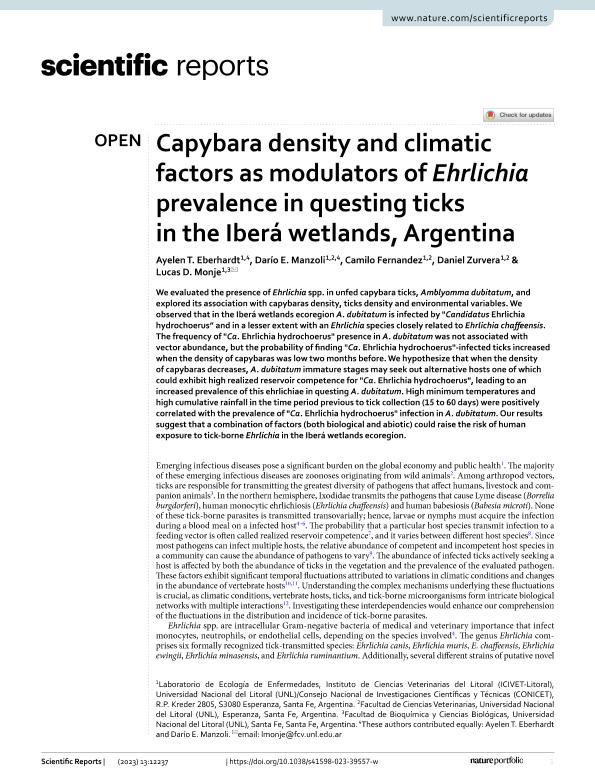Artículo
Capybara density and climatic factors as modulators of Ehrlichia prevalence in questing ticks in the Iberá wetlands, Argentina
Eberhardt, María Ayelen Teresita ; Manzoli, Darío Ezequiel
; Manzoli, Darío Ezequiel ; Fernández, Camilo; Zurvera, Daniel; Monje, Lucas Daniel
; Fernández, Camilo; Zurvera, Daniel; Monje, Lucas Daniel
 ; Manzoli, Darío Ezequiel
; Manzoli, Darío Ezequiel ; Fernández, Camilo; Zurvera, Daniel; Monje, Lucas Daniel
; Fernández, Camilo; Zurvera, Daniel; Monje, Lucas Daniel
Fecha de publicación:
07/2023
Editorial:
Nature Research
Revista:
Scientific Reports
e-ISSN:
2045-2322
Idioma:
Inglés
Tipo de recurso:
Artículo publicado
Clasificación temática:
Resumen
We evaluated the presence of Ehrlichia spp. in unfed capybara ticks, Amblyomma dubitatum, and explored its association with capybaras density, ticks density and environmental variables. We observed that in the Iberá wetlands ecoregion A. dubitatum is infected by "Candidatus Ehrlichia hydrochoerus” and in a lesser extent with an Ehrlichia species closely related to Ehrlichia chaffeensis. The frequency of "Ca. Ehrlichia hydrochoerus" presence in A. dubitatum was not associated with vector abundance, but the probability of finding "Ca. Ehrlichia hydrochoerus"-infected ticks increased when the density of capybaras was low two months before. We hypothesize that when the density of capybaras decreases, A. dubitatum immature stages may seek out alternative hosts one of which could exhibit high realized reservoir competence for "Ca. Ehrlichia hydrochoerus", leading to an increased prevalence of this ehrlichiae in questing A. dubitatum. High minimum temperatures and high cumulative rainfall in the time period previous to tick collection (15 to 60 days) were positively correlated with the prevalence of "Ca. Ehrlichia hydrochoerus" infection in A. dubitatum. Our results suggest that a combination of factors (both biological and abiotic) could raise the risk of human exposure to tick-borne Ehrlichia in the Iberá wetlands ecoregion.
Palabras clave:
ANAPLASMATACEAE
,
ALTERNATIVE HOST
,
AMBLYOMMA DUBITATUM
,
SOUTH AMERICA
Archivos asociados
Licencia
Identificadores
Colecciones
Articulos(ICIVET-LITORAL)
Articulos de INST. DE CIENCIAS VETERINARIAS DEL LITORAL
Articulos de INST. DE CIENCIAS VETERINARIAS DEL LITORAL
Citación
Eberhardt, María Ayelen Teresita; Manzoli, Darío Ezequiel; Fernández, Camilo; Zurvera, Daniel; Monje, Lucas Daniel; Capybara density and climatic factors as modulators of Ehrlichia prevalence in questing ticks in the Iberá wetlands, Argentina; Nature Research; Scientific Reports; 13; 1; 7-2023; 1-9
Compartir
Altmétricas



